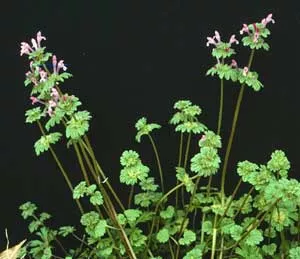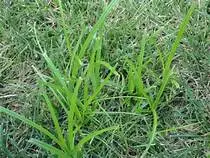Types of Weeds in Middle Georgia

There are many species of weeds and invasive grasses that can ruin the look and health of your lawn. Learn more about these weeds below and contact the team here at Roots Turf and Ornamental for weed control services that will have your lawn looking its best in no time!
American Burnweed/Fireweed

This is a rapidly growing annual spring/summer weed that is known for its QUICK emergence and unsightly appearance. American Burnweed tolerates moderate shade, but requires moist well-drained soil. Its seeds have the ability to germinate in the thatch layer of turf, which makes the use of pre-emergent herbicides somewhat problematic. If noticed in the lawn simply applying a post-emergent herbicide, labeled for use, will control this weed. You can always call the pros here at Roots and let us take care of the problem.
Dandelion

This perennial weed overwinters as a small rosette of leaves. Seedlings grow from a taproot and begin to emerge in early spring. Dandelions prefer moist conditions and soils, but thrive in weak, thin turf. Applying a pre and post emergent herbicide, in early spring when temperatures are still cool, will provide solid control. Our lawn care programs will easily keep this unsightly weed OUT of your lawn year-round.
Henbit

This flowering annual winter weed thrives in thin, nutrient-rich soil and can reach nearly 10 inches in height. It’s a distinct weed known for its purple flowering aesthetic during the cooler season. Applying a pre-emergent herbicide in late summer/early fall, before the weed germinates, will provide good control. If the weed is actively growing in the turf, a selective post-emergent herbicide is recommended for control.
Wild Garlic/Onion

This perennial weed grows from bulblets that emit a strong garlic or onion smell when crushed. Wild garlic can be difficult to completely eradicate because several bulblets will sprout and grow at different times form the plant. Two treatments are recommended using a selective post emergent herbicide for control. A preemergent herbicide applied in late summer/ early fall, before the weed’s germination, will provide control against the weed emergence.
Poa Annua (Annual Bluegrass)

This annual grass tolerates close mowing practices. Cultural practices can reduce Poa Annua, but herbicides are needed for superior control. Once soil temperatures fall below 70 F, germination of Poa Annua will begin. Apply a pre-emergent herbicide before the weed seed germinates, for best control. Develop a dense, healthy turf to reduce sunlight at the soil surface. Keep soil phosphorous levels in the low to medium range to help with the emergence of this weed. If action is not taken BEFORE the weed germinates, costly post-emergent applications will be needed to gain optimal control.
Crabgrass (Large, Smooth, & Southern)

This annual, warm-season, grassy weed reproduces by seed and forms dense stands in open/disturbed or thin-canopy sites. Crabgrass typically germinates when soil temperatures reach a consistent 55 F. For best control, apply a crabgrass preventative preemergent herbicide to the turf BEFORE the point of seed germination. If applied appropriately season long control is promised. Don’t forget you can always call the pros here at Roots for any weed control needs. We are experts in crabgrass prevention and our programs PROVE season long control on this aggressive annual weed.
Dallisgrass

This abundant seed producing perennial grows in clumps with a tall, membranous ligule. Dallisgrass seed begins to emerge when soil temperatures reach 60 F. If present in turfgrass, the best way to eradicate dallisgrass is by digging out the clumps prior to formation of rhizomes or seed set. With proven result, there are very few herbicides on the market that will kill/control dallisgrass. This weed has even shown reemergence after the use of glyphosate (round up). Persistent use of herbicides, penetrating the weed, and replanting/resodding the desired area will provide control but not always guaranteed.
Chamber Bitter

Also known as a “little mimosa tree”. It is a warm-season, annual, broadleaf weed that emerges from warm soils beginning in early summer. It reproduces by seeds, which are found in the green, warty-like fruit attached to the underside of the branch. Management of chamber bitter is best achieved through the integrated use of mechanical, cultural, and chemical methods. Because preemergence herbicides prevent seedlings from developing, they are an effective tool against annual weeds. However, they will not affect established weeds. Timing is critical. They must be applied prior to seed germination. Multiple treatments are required for control if action is not taken before the weed germinates.
Spurge

Spotted and Prostrate spurge is a very adaptable weed and can thrive in many soil structures including clay and sand-based soils; Concrete, asphalt cracks, and ornamental beds. It is a summer annual with a central taproot. Spotted spurge leaves are green, small, less than 5/8 of an inch, oval and close to the stem with a reddish dot. Seed germination happens anywhere between 60-90 F. Applying a preemergent herbicide before the point of seed germination will provide control. If the weed is past the point of germination, multiple applications of a post-emergent herbicide will be needed for control efforts.
Virginia Buttonweed

Virginia buttonweed is a deep-rooted perennial with prostrate or spreading branches. It usually proliferates in moist, wet, thin areas of turfgrass. Most preemergence herbicides provide poor control (< 70%) of Virginia buttonweed in turf. Some preemergence herbicides have the potential to control Virginia buttonweed, emerging from seed, but results are often inconsistent. Proper post emergent herbicides will control Virginia buttonweed in turfgrass, after the point of seed germination. Often times 1 or more applications are needed.
Doveweed

Doveweed is an aggressive, naturalized summer annual weed. It rapidly invades warm-season turfgrass species, especially in residential lawns, and few herbicides can effectively control it. Doveweed seeds start germinating late in the spring, when soil temperatures reach 65°F–70°F. Doveweed prefers wet areas, so drainage issues or overwatering will favor the establishment and growth of this weed. Pre-emergent applications early in the year, targeted for crabgrass control, provide very little effect for the control of doveweed considering its late season emergence. Product selection and application timing is key for good control.
Goosegrass

Goosegrass is commonly found in highly trafficked areas with compacted soil and poor turfgrass coverage. It germinates when soil temperatures reach 60 to 65°F, and requires moisture and light for germination. Some post emergent herbicides have built a resistance to goosegrass control. Multiple applications are required if action is not taken before the point of seed germination.
Sedges - (Yellow Sedge, Purple Sedge, Green Kyllinga)

Most nutsedges are perennials whose leaves die back in the fall when temperatures decrease. Tubers (often called “nutlets”) and rhizomes (underground stems) survive in the soil and sprout the following spring. The tubers and rhizomes can grow eight to 14 inches below the soil surface. Nutsedges thrive in moist areas and their presence often indicates that drainage is poor, irrigation is too frequent, or sprinklers are leaky. Once established, however, they will tolerate normal moisture levels or even drought. Nutsedge tubers are spread by cultivation and introduced in topsoil and nursery stock. They can persist in the soil for years making them nearly impossible to prevent through pre-emergent applications.
Bahia Grass

Bahia grass is a long-lived, perennial warm season grass. It is an ACTUAL grass but NOT a desired turf type. Bahia grass is a deep-rooted, sod-forming species that is well adapted to a wide range of soils and conditions in this region. Bahia grass is particularly well suited for use in pastures but very rarely desired in residential lawns. Its persistence makes it difficult to control in home lawns which requires specialty applications for proper control without the sight of turf injury.
Lespedeza

Common lespedeza, also known as Japanese clover, is a very common summer annual weed that can easily choke out thin turf. Common lespedeza grows well in thin turf and dry, compacted areas. To discourage lespedeza’s growth, it is recommended to increase the mowing height and to keep the soil’s pH and fertility at correct levels for the turf grass species. Cultural controls should first be implemented before applying herbicides for lespedeza control. Herbicides should be carefully chosen according to turf species and all label instructions followed. Simply applying a preemergent herbicide before the point of seed germination is proven to provide good control of common lespedeza.
